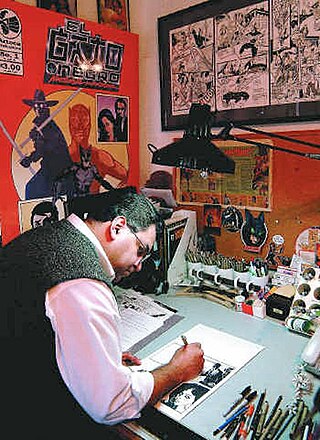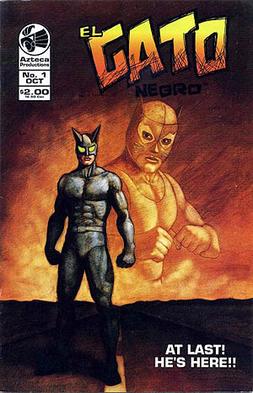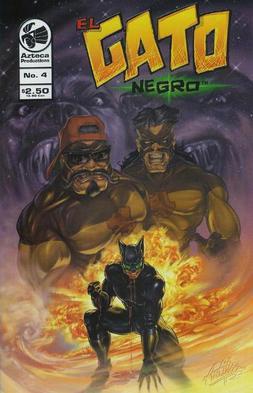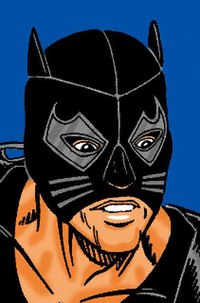
Jorge Ernesto Guzmán Rodríguez is a Mexican luchador enmascarado, or masked professional wrestler and political activist, best known under the ring name, El Hijo del Santo. Guzmán is the youngest child, out of eleven, of Rodolfo Guzmán Huerta, better known as El Santo, a professional wrestler, film actor, and Mexican folk hero. Jorge Guzmán's son made his debut under the name "Santo Jr.", the third-generation Guzmán to use the name "Santo". Jorge Guzmán's uncles, Miguel "Black" Guzmán, Jesús Guzmán and Jimmy Guzmán were also wrestlers. Axxel, Jorge Guzmán's nephew, originally wrestled as "El Nieto del Santo" but Jorge Guzmán owned the rights to the "Santo" name and objected. Guzmán has also followed in his father's footsteps, as he has starred in several lucha films.

Richard Dominguez is an American comic book artist and freelance storyboard illustrator. Best known for creating the popular series El Gato Negro, Dominguez publishes his comics through his imprint and art studio, Azteca Productions. Dominguez also is well known for influencing other artists and creators in the pursuit of their own self-publishing ventures.>

El Gato Negro is the name of two fictional American comic book superheroes created by Richard Dominguez and featured Azteca Productions' Universe. Both characters made first appearance in El Gato Negro #1.

El Gato Negro, Nocturnal Warrior is an ongoing independent comic book series featuring the adventures of the superhero, El Gato Negro. Created by Richard Dominguez and published under his own Azteca Productions imprint, the series began in November 2005. It is now being compiled online at webcomicsnation.com

Azteca Productions is an American comic book publisher and imprint founded by comics creator Richard Dominguez in 1993. The company's first publication was El Gato Negro #1 showcasing the debut of the eponymous character, in what is now considered the company's flagship series. Publications went on hiatus during the rise and fall of the speculative market in the late 1990s until Dominguez returned in 2004.

Armando Ochoa, also known as El Graduado, is a fictional character and comic book supervillain created by Richard Dominguez and published by Azteca Productions. The character made his first appearance in El Gato Negro #1.

El Gato Negro was an independent comic book series featuring the eponymous character created by Richard Dominguez and published by Azteca Productions. The series began in October 1993; the first edition sold all 5,000 copies within two months, but was placed on a seven-year hiatus after the fourth issue was published. Dominguez later returned in 2005 with the new series El Gato Negro: Nocturnal Warrior.
El Gato Negro, Spanish for The Black Cat, may refer to:

Francisco "Pancho" Guerrero, Jr., also known as El Gato Negro, is a fictional character and comic book superhero created by Richard Dominguez and published by Azteca Productions. The character made his first appearance in El Gato Negro #1.

Jose Luis Arias Romero (December 20, 1951 – December 29, 2013), was a Mexican professional wrestler who wrestled in Mexico, the United States and Japan, under the ring name Ari Romero. Romero earned the nickname "El Rey del Tenedor" by using a fork to make his adversaries bleed in his matches. He was also nicknamed "El Rey de las Cadenas".

The Dogs of War, also known as The Briones Brothers, is a fictional supervillain duo created by Richard Dominguez and published by Azteca Productions. Both characters made a cameo appearance in the conclusion of El Gato Negro #3 and made their first "full" appearance in El Gato Negro #4.
El Observador is a fictional character and comic book supervillain appearing in comic books published by Azteca Productions. Co-created by Richard Dominguez and Michael S. Moore, the character made his first appearance in El Gato Negro: Nocturnal Warrior #1.

Miguel Bustamonte is a fictional character who appears in comic books published by Azteca Productions. Created by Richard Dominguez, the character made his first appearance in El Gato Negro #1. He was the first supporting character to be introduced El Gato Negro mythos and has been a recurring character since then.

José Ángel Vargas Sánchez was a Mexican Luchador or professional wrestler best known under the ring name Angel Blanco. Vargas is the father-in-law of the first Ángel Blanco Jr. and the father of the current Ángel Blanco Jr. and Hijo del Ángel Blanco I and II, as well as the grandfather of Horus. Vargas made his professional wrestling debut in 1958 and worked for the majority of his career for the Mexican professional wrestling promotion Empresa Mexicana de Lucha Libre (EMLL). As Ángel Blanco he worked most of his career as an enmascarado, or masked wrestler until losing his mask to El Solitario 1972. Along with Dr. Wagner, Vargas formed one of the premier tag teams of the 1960s and 1970s called La Ola Blanca.

Guerrero Maya Jr. is a Mexican luchador enmascarado, currently working for the Mexican professional wrestling promotion Consejo Mundial de Lucha Libre (CMLL). He portrays a tecnico wrestling character. Guerrero Maya Jr.'s real name is not a matter of public record, as is often the case with masked wrestlers in Mexico where their private lives are kept a secret from the wrestling fans. He is the son of Esteban Mares Castañeda, better known under the ring names Black Terry and Guerrero Maya. He has previously competed as the enmascarado characters Samba and Multifacético.

Negro Navarro is the ring name of Miguel Calderón Navarro, a Mexican luchador, or professional wrestler. Navarro works as a Freelancer on the Mexican independent circuit as well as making regular appearances for International Wrestling Revolution Group (IWRG). Navarro often teams with his sons, who are known as Trauma I and Trauma II. Negro Navarro was part of Los Misioneros de la Muerte with El Signo and El Texano; a team that is credited with popularizing the Trios match in Mexico to the point that it became the most common match for Trios teams in Mexican Lucha Libre.
Los Misioneros de la Muerte was a Mexican Lucha libre, or professional wrestling Trio that has been credited with making the two out of three falls six-man tag team match the most common match form in Mexico instead of the traditional one-on-one match that is the most common match everywhere else besides Japan. The original Los Misioneros trio consisted of Negro Navarro, El Signo and El Texano and worked together as a unit from 1977 until 1987. Later versions of Los Misioneros featured Navarro and Signo teaming with wrestlers such as Black Power, Rocky Santana or El Texano, Jr. but their success never approached the success of the original team. The original Los Misioneros would occasionally reunite in the years following their 1987 break-up, but with the 2006 death of El Texano the Los Misioneros de la Muerte was not used by Navarro and El Signo. El Signo retired in 2010, making Negro Navarro the only active competitor left of the trio.
Esteban Mares Castañeda is a Mexican luchador, or professional wrestler, better known by the ring name Black Terry. Wrestling since 1973, he was once part of a group called Los Temerarios alongside Jose Luis Feliciano and Shu El Guerrero. He has previously worked as the masked character Guerrero Maya where he formed the group called Los Guerreros Del Futuro with Guerrero del Futuro and Damian El Guerrero. He is the father of wrestler Guerrero Maya Jr. although the relationship is not officially recognized due to Guerrero Maya, Jr. being a masked wrestler.
















